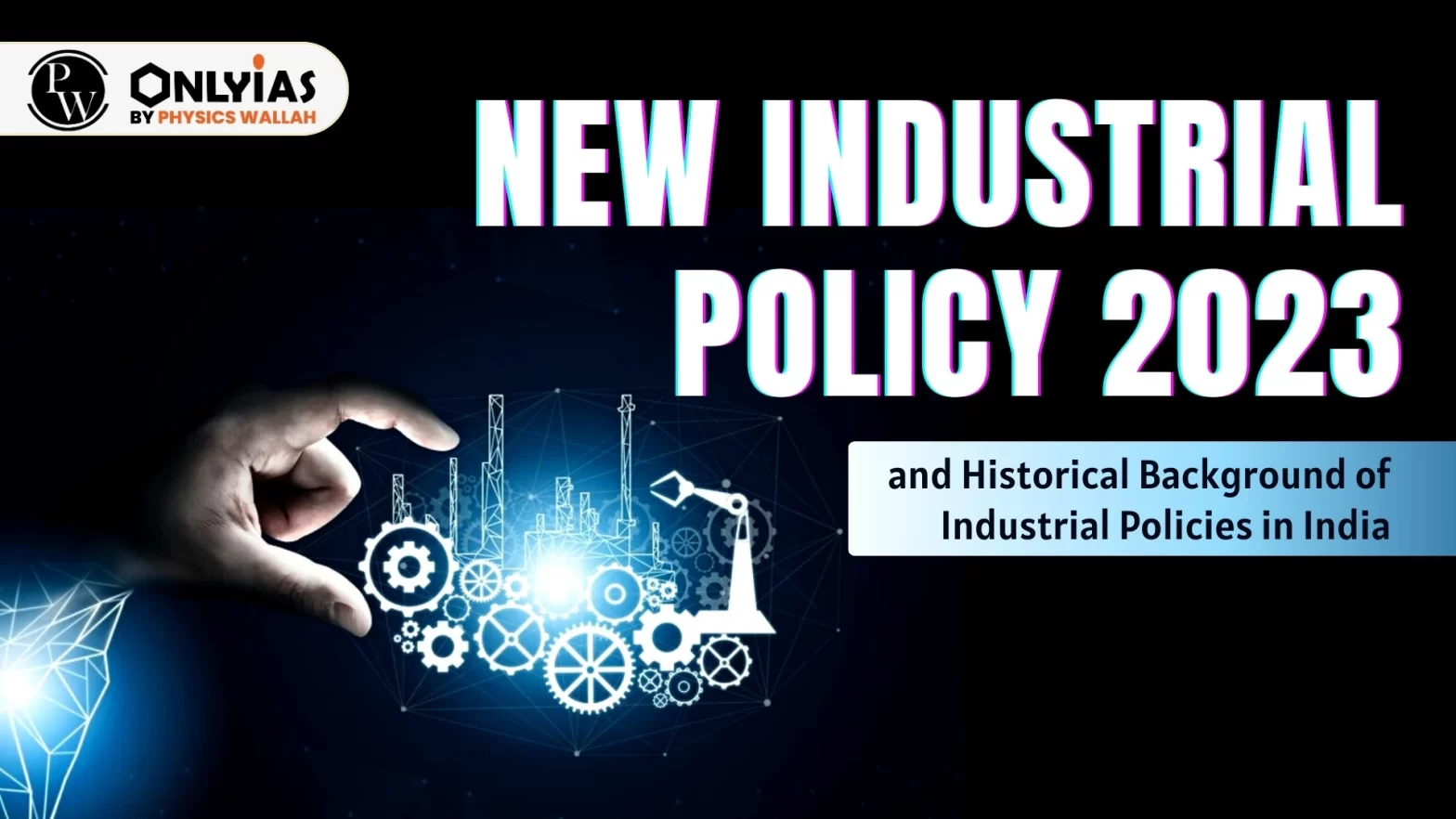Context: The government has put the implementation of the New Industrial Policy 2023 (NIP 2023) on hold which has been under development for more than two years.
| Relevancy for Prelims: Industrial Policies in India: Industrial Policy Resolution (IPR) 1948, Industrial Policy Resolution (IPR) 1956, Industrial Policy 1977, Industrial Policy of 1980, Industrial Policy of 1991, and New Industrial Policy 2023.
Relevancy for Mains: New Industrial Policy 2023, and Historical Background of Industrial Policies in India. |
Enroll now for UPSC Online Course
About New Industrial Policy 2023
- Replacing 1991 Policy: The Union Commerce Ministry released the draft of a new Industrial Policy to replace the 1991 policy.
- Disruptions in Economic Activity: The new industrial policy has been fuelled primarily by the disruptions in economic activity due to the COVID-19 pandemic and the shocks driven by uncertainties and disruptions in supply chains.
- Objectives of New Industrial Policy 2023: It has two objectives:
- Enhance the pace of economic activity at the national level
- Devise mechanisms to impart resilience to the industrial sector.
Historical Background of Industrial Policies in India
- Industrial Policy Resolution (IPR) 1948
- Industrial Policy Resolution (IPR) 1956
- Industrial Policy 1977
- Industrial Policy of 1980
- Objectives of Industrial Policy of 1991
- Challenges with the Industrial Policy of 1991
Enroll now for UPSC Online Classes
Industrial Policy Resolution (IPR) 1948
- It classified industries into four broad areas:
- Strategic Industries (Public Sector): The Central Government had monopoly: arms and ammunition, atomic energy, and rail transport.
- Basic/Key Industries (Public-cum-Private Sector): These industries were to be set-up by the Central Government. Ex- Coal, iron & steel, aircraft manufacturing, shipbuilding.
- Important Industries (Controlled Private Sector): Existing private producers in these industries could continue under the private sector.
- However, in consultation with the state government, the central government had general control over them.
- Other Industries (Private and Cooperative Sector): All other industries not included in the above-mentioned three categories were left open for the private sector.
Industrial Policy Resolution (IPR) 1956
- With this, the list of industries reserved for the public sector was expanded to cover 14 industries in which new establishments were to be set up only by the state. It classified industries into three categories:
- Schedule A: It consisted of 17 industries which were the exclusive responsibility of the State.
- Out of these 17 industries, four industries, namely arms and ammunition, atomic energy, railways, and air transport had Central Government monopolies; the State Governments developed new units in the remaining industries.
- Schedule B: It consisted of 12 industries open to private and public sectors.
- Schedule C: Other industries not included in these two Schedules were included under this category and left open to the private sector.
- However, the State reserved the right to undertake industrial production.
Enroll now for UPSC Online Coaching
Industrial Policy 1977:
- Its main focus was promoting cottage and small industries effectively.
- Under this, the small sector was classified into three groups—cottage and household sector, tiny sector and small-scale industries.
- It prescribed different areas for the large-scale industrial sector:
- Basic industries
- Capital goods industries
- High technology industries
- Other industries outside the list of reserved items for the small-scale sector.
- It restricted the scope of large businesses to prevent a dominant and monopolistic position in the market.
- Industrial Policy of 1980: It sought to reverse the trend of industrial production and reaffirm its faith in the Monopolies and Restrictive Trade Practices (MRTP) Act and the Foreign Exchange Regulation Act (FERA).
Objectives of the Industrial Policy of 1991:
- Industrial Licensing
- Public Sector Disinvestment
- Increase in Foreign Direct Investment
- Introduction of foreign technology to India
- Increasing public investment in infrastructure.
Enroll now for Online Course
Challenges with the Industrial Policy of 1991
- Incomprehensive Economic Policy: India’s economy shifted from a predominantly agrarian society to an economy propelled by services bypassing the traditional industrial development.
- This is known as the “missing middle” phenomenon where growth in manufacturing & industry with their ability to absorb large-scale labour is missing.
- Also, jobs tend to be concentrated in either highly skilled service-driven industries like IT and financial services or in very low productive farm and construction-related sectors
- Traditional Industrial development led to growth of China and led to the formation of a dynamic middle class.
- Stagnant Manufacturing Sector: Despite the significant diversification of manufacturing observed in East Asian countries since the late 1970s, India’s manufacturing share has remained stagnant at approximately 15% of the GDP.
- According to the employment and unemployment survey of the National Statistical Office (NSO), manufacturing accounted for 12.6% of all workers in 2011-12 which declined to 11.6% in 2021-22.
- Crisis of Unemployment: According to data from the Centre for Monitoring Indian Economy (CMIE), India’s unemployment rate increased to 8.11% in April 2023.
- Moreover, more than 80% of the workforce in India is engaged in the informal sector.
- There is a huge lack of skilled employees in India and an increase in automation may further reduce the workforce, increasing the unemployment rate.
- Outpacing Traditional Brick-and-Mortar Model: Indian consumers have bypassed the organized retail model in developed economies, opting for local stores or online platforms.
- This trend could adversely affect sector development by disincentivizing investments into backend infrastructure and logistics.
- Unlike private organized retail, a major employment generator in countries like the UK, e-commerce has limited capacity to absorb labor due to increasing automation and technological advancements.
- It might deprive India of an estimated 10 million new jobs.
Enroll now for UPSC Online Classes
- Imbalances Across Sectors: India’s growth trajectory, skipping crucial developmental stages, has led to imbalances and fractures across various sectors, including retail, manufacturing, sustenance, healthcare, education, and housing.
- Ex- In education, few institutions like IITs and IIMs produce top graduates while there’s a decline in the proportion of children in class 5 who can read a class 2 level text.
- Despite the emergence of India as a health tourism destination, India ranked 111 out of 125 countries in the Global Hunger Index (GHI) 2023 behind neighbors Pakistan (102), Bangladesh (81), Nepal (69) and Sri Lanka (60).
- Rising Inequalities: Although expanding high-skill services may result in higher average incomes, these benefits are inherently concentrated among workers directly engaged in those sectors.
- Consequently, states with higher growth in high-skill services often witness increased inequality.
- For instance, in Karnataka, approximately 5% of the workforce is directly employed in business services, including IT/ITeS, contributing around one-third of the state’s gross value added.
- According to a recent NBER paper titled ‘Growing like India: Unequal effects of service-led growth’, productivity growth in services was an important driver of rising living standards in the country between 1987 and 2011.
- However, the welfare gains were heavily skewed in favor of the high-income urban population.
Way Forward
- Reforms Needed in Draft New Industrial Policy 2023:
-
- Development Finance Institution (DFI): It should create a DFI using India’s forex reserves to provide low-cost finance, and a technology fund to incentivize companies in advanced technology areas.
- One Nation-One Standard: It should ensure the availability of quality products, promote start-ups across rural and urban areas, and push for innovation at urban local bodies.
- Mega Clusters: It also included a plan to develop mega clusters to integrate with global supply chains and to help small businesses access corporate bond markets.
- Policy for Tackling Current Global Dynamics: Dealing with climate change, green energy commitments and the West’s China-plus-one strategy.
- Universal Enterprise ID for micro, small and medium enterprises (MSMEs): This will strengthen their credit rating mechanism and MSME cluster financing models.
Enroll now for UPSC Online Coaching
- Surplus Agriculture Labour: An expanding manufacturing sector may absorb much of the surplus labour from agriculture and other “subsistence” sectors.
-
- Hence focus should be on the development of labour labor-intensive manufacturing sectors such as Textile and Apparel and Shoe Manufacturing.
- As per the National Sample Survey Office’s Periodic Labour Force Survey report for 2022-23 (July-June), the current farm sector’s share in the country’s employed labour force increased to 45.8% share.
To read more about PLFS Report, refer: Periodic Labour Force Survey (PLFS) Annual Report 2022, here.
- Tax Incentives: The concessional tax rate of 17% is available only to those manufacturing companies which will commence before March 2024.
- Given the required thrust on manufacturing, NIP’23 should extend the date by a 2-3-year period.
- Extension of PLI Scheme to other sectors: NIP’23 should identify sectors for the extension of PLI, considering the China + 1 opportunity.
- With the world’s excessive reliance on China for manufactured exports, it is probable that global economies will opt for diversification in their imports of services rather than depending on a single country like India.
- The government implemented the production-linked incentive (PLI) scheme to incentivise domestic production in strategic growth sectors where India has comparative advantage.
- Balancing Manufacturing as well as Services Sector: Investment in the manufacturing sector and government support will help in providing jobs to unskilled and semiskilled workers as most mass manufacturing jobs do not require higher levels of education.
- Since, the services sector needs supply of skilled and trained manpower, which has been a longstanding challenge for India, including the IT industry.
Enroll now for UPSC Online Course
-
- This issue is less critical in manufacturing, where on-the-job training holds greater importance.
- Uttar Pradesh (UP) and Bihar, constituting nearly 30% of India’s population, rank as the weakest states in terms of education quality.
- Intervention for unskilled and low-skill sector: India needs policy intervention that can push production and exports in sectors such as textiles, leather, and footwear on the lines of Bangladesh.
Bangladesh Model for Readymade Garments (RMG) Industry
- According to the recent data released by Eurostat, Bangladesh, for the first time, overtook China to become the top knitwear exporter to the European Union between January and September 2023.
- It is also one of the top cotton apparel suppliers in the world, other than China and Vietnam.
- The Bangladesh Garment Manufacturers and Exporters Association reported that the United States is the largest export destination for Bangladeshi garments.
- Bangladesh’s success in the RMG and textiles sector can be credited to its focus on investing in high value-added items and prioritizing the export of labor-intensive goods.
- Its efforts in skilling, reskilling, and upskilling to adapt to the evolving dynamics of garment manufacturing have enhanced the competitiveness of its exports.
|
Conclusion:
The Union Commerce Ministry has shared a draft for a new Industrial Policy called “Make in India for the World,” set to replace the 1991 policy. This policy aims to address industry challenges, promote innovation, and create a competitive industrial environment in the country.
Enroll now for UPSC Online Classes
To get PDF version, Please click on "Print PDF" button.

